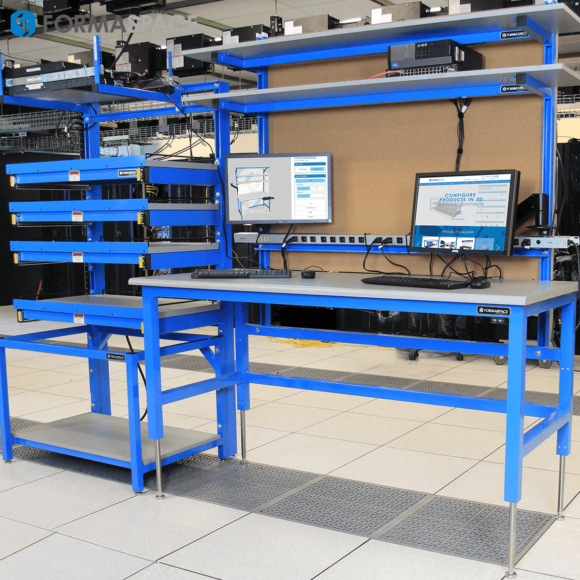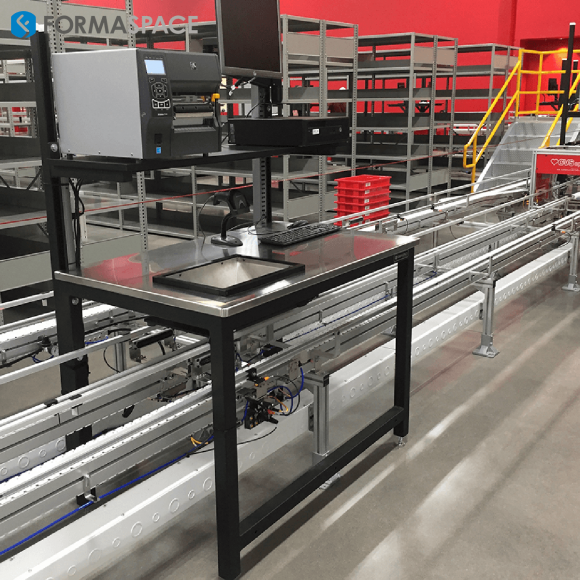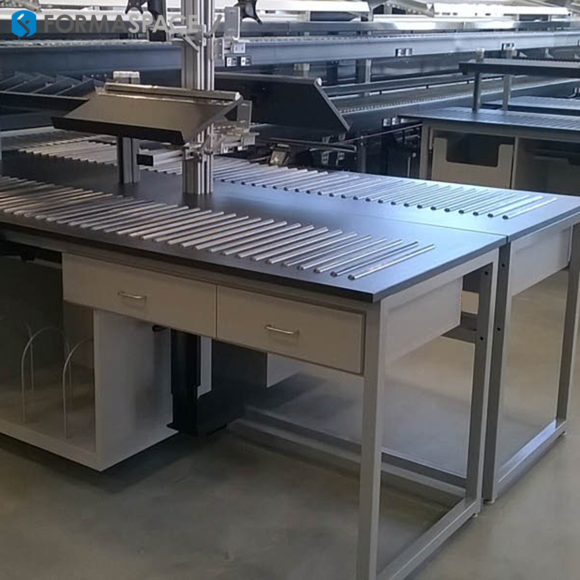Despite decades of innovation across the computer industry, supply-chain managers have remained pretty frustrated over the years by the challenge of implementing robust, real-time inventory tracking systems.
Much like Goldilocks sampling the bowls of porridge at the table of the Three Bears, supply-chain managers evaluating these systems often found it difficult to identify a solution that was “just right.”
![]()
Many systems were too expensive and too complex to implement, while simpler versions often lacked sufficient flexibility to be useful in real-world conditions. And many of the earlier systems were overly dependent on workers inputting data manually, making data collection subject to human error.
Hosted Cloud Computing Platforms are enabling a Golden Age in Real-Time Inventory Management
So what has changed?
Well, it took a while, but it appears that cloud-based software platforms (which allow software vendors to provide applications under the moniker of software as a service) have matured to the point where real-time inventory tracking systems, hosted in the cloud, are gaining acceptance among supply-chain IT professionals who have heretofore been pretty skeptical about giving third-party vendors deep access to critical company infrastructure.
Cloud-based real-time inventory systems offer many advantages.
Firstly, cloud-based tools solve a problem that bedeviled systems based on older technology, the issue of data replication. Older systems often suffered from delays in updating the central database, because updates from the field were usually processed in batches that snaked their way up to the central database. But relying on batch updates defeats the purpose of real-time visibility, as the data is already becoming stale by the time the batch upload is complete. In contrast, well designed cloud-based databases allow multiple data inputs to be gathered (and processed) concurrently, from any location with a secure Internet connection.

The second advantage of cloud-based real-time inventory management systems is the potential savings in implementation and operating costs. Because these are complex systems to operate, update, and maintain, many businesses (particularly cost-conscious SMEs) often find it’s more economical to pay a monthly subscription fee rather than deploy a dedicated team to implement a home-brewed internal system. Many vendors also offer multiple service tiers to allow companies the option of just paying for services as needed (pay as you go) rather than having to make a big upfront investment.
There is a third potential advantage of using cloud-based inventory management services — thanks to the so-called network effect, in which a computer service becomes more valuable as more companies adopt the same system.
For example, if your company implements the same inventory control systems as one of your suppliers or customers, it opens up the possibility of sharing confidential inventory data without the need for complex data translation processes (by using the same vendor, there is a greater chance your data structures will be in alignment).
Of course, there are some downside risks as well. Security remains a primary concern for everyone involved. Intimate knowledge of a company’s supply chain operations, including current order book and pricing, are valuable trade secrets that need to remain confidential.
On the other hand, it may be reassuring to realize that most vendors offering cloud-based real-time inventory control systems understand their very existence depends on maintaining high levels of trust.
What to Expect When Migrating to a Real-Time Inventory Control System
So what can your organization expect when implementing a real-time inventory management system?
To give a comprehensive answer would take the length of an entire book, so we will try to boil this down into three components.
First, we will touch on ways that real-time inventory tracking systems can enhance long-standing best practices in supply chain management.

After that, we’ll take a look at some of the pitfalls and tricky areas to consider when designing new data structures for your real-time tracking system implementation.
And, finally, we’ll take a peek at how rapid advances in AI algorithms and big data analysis are starting to leverage real-time inventory data, bringing sophisticated automation tools to inventory management decision-making.
Real-Time Inventory Tracking Reinforces Best Practices in Supply Chain Management
Having reliable access to real-time inventory tracking is a dream come true for supply chain managers.
Accurate, up-to-date information on inventory data provides managers with greater visibility as to what’s happening on the ground and allows them to, in the words of Ronald Reagan, “trust but verify” if the organization is operating at peak efficiency.
If discrepancies are found, managers can use the data to identify areas of concern in a timely manner so corrective action can be taken before it’s too late.
In this sense, real-time inventory tracking is just another tool in the toolkit, but a very powerful one. It gives managers the insight needed to improve time-sensitive operations, whether it’s just in time (JIT) deliveries at an auto manufacturing plant, precision cross-docking at distribution centers (DCs), or monitoring whether stock is being rotated properly (FIFO), particularly in the food industry.

Having access to real-time information also helps facilitate some of the newer trends in logistics, such as drop shipping operations (where sellers never touch the inventory they are selling), the transformation of traditional kanban system (originated by Toyota) into e-kanban (which allows virtual kanban bins to be transmitted electronically between suppliers and manufacturers), as well as the rise of more local distribution centers (DCs), which allow logistics companies to get closer to their end customers. (Amazon, a Formaspace customer, is leading the charge, by converting underutilized shopping malls throughout the country into local warehousing and distribution centers.)
Get the Details Right When it comes to Complex Edge Cases
At first glance, it might look like implementing a real-time inventory tracking system is a piece of cake.
In principle, it should be. Cloud-based technology makes it easy to capture data anywhere you have a secure internet connection. And if you make savvy choices about automating the data upload process, the implementing process for most use cases will be fairly straightforward.
The selection of a specific data collection technology, whether it’s a bar code, RF ID tag, or, in the case of connected devices, status updates sent out over the network, often comes down to a choice between operational efficiency and cost. (For example, in high volume scenarios, bar codes can be cheaper, but RF ID tags can be read without unpacking a plastic-wrapped pallet in the warehouse).
Whichever method is selected, the important thing is to capture data every time the inventory is “touched” – without requiring workers to do any manual data entry.
Seems pretty straightforward, right?
But not everything is a simple case.
Here, we’ll borrow the term “edge cases,” which computer programmers use to refer to complicated scenarios that require special attention.
Consider a manufacturing company. As they take delivery of a shipment of raw materials, each item is duly recorded and uploaded to the cloud. Great!
But once these raw materials get turned into WIP (work in progress), things can get a little complicated. We can use Formaspace as an example: once a piece of heavy-duty steel stock is cut to fashion the leg of a workbench, the real-time inventory control system will need account for this change, as we now have partially completed workbench (and a shorter piece of steel on the shelf).

Manufacturing companies assembling components supplied by different vendors also face challenging edge cases that the database designer needs to account for.
Take the case of a car company building starter motors; they might rely on several vendors to supply components, such as solenoids. The database architect will need to consider the implications carefully: one production lot of starters might include a solenoid made by Vendor A while a different lot might use solenoids from vendor B.
Capturing this information in a useful method can be crucial. (We chose solenoids as our example as they have proven to be a fire risk for numerous vehicles in the past – should a consumer recall be needed, knowing exactly which of the vehicles used the recalled solenoid could prevent having to recall all the vehicles, potentially saving millions of dollars.)
Pharmaceutical product manufacturing faces many edge cases as well. For example, FDA regulations require the entire pharma supply chain – from raw material manufacturers to pharmaceutical producers, to your local pharmacy – to document each step of the production process (known as the “chain of custody”) that would facilitate a future investigation or recall if needed.

Logistic operators in the e-commerce space have their own edge cases to worry about as well. Among their top challenges is how to handle returns (RMAs) in an efficient way that keeps consumers satisfied while reducing the costs associated with processing a return. This makes it critical for the real-time inventory tracking system to include provisions for returning products for rework (or other means of disposal).
Leverage Big Data and AI to Automate Supply Chain Decisions
So far, we’ve looked at how real-time inventory tracking can support existing best practices as well as some of the complicated edge cases that need to be thoughtfully considered before signing off on a database schema.
Now let’s look to the future.
For technology-focused companies, such as Amazon and Walmart, real-time inventory tracking is nothing new; it’s been part and parcel of their operations for many years.
But what’s revolutionary is what they can do with the data.
Importantly, the real-time data they are now collecting has less to do with the products they sell and more to do with capturing the behavior of their individual customers.

In other words, the scope of real-time inventory data collection now includes us – every click we make on an e-commerce website, every credit card purchase we make, every promotion we respond to, every move we make (tracked by their handy mobile app), and every purchase that we make becomes part of the larger profile that these tech companies maintain on each of their customers.
Anticipating customer behavior is nothing new. Back in the day when a cold winter was forecast (remember them?), apparel companies would ramp up their production of winter jackets, and clothing retailers would order more stock to meet the anticipated increase in consumer demand.
But by today’s standards, that approach seems almost quaint.
Big data analysis (using powerful AI technology) is transforming demand forecasting to a new level, one that is incredibly granular, e.g. capable of drilling down to the specific behavior of individual consumers.
Armed with this vast amount of data, companies such as Walmart and Amazon are moving to a world where their supply chain management systems have the uncanny ability to predict consumer behavior and to react automatically, using sophisticated computer algorithms.
For example, do you order a household product online on a fairly regular basis from a big tech e-commerce giant? If so, they have taken notice. There’s a good chance inventory has been shifted to a DC closer to your location as they wait for you to reorder.
This ability to leverage real-time inventory tracking with advanced AI decision-making is just one way that big tech companies have become more powerful during the Coronavirus pandemic.
We’ll take a detailed look next week at how these tech companies (as well as companies in other market sectors) have been able to increase their sales during a difficult economic period.
Formaspace is Your Logistics Partner
If you can imagine it, we can build it.
Formaspace manufactures all its furniture in the USA, here at our Austin, Texas factory headquarters.
We are dedicated to making your operations run more efficiently, whether you are operating a factory, a laboratory, a distribution center, or an educational facility.
Find out more today.
Contact your Formaspace Design Consultant today to see how we can work together to make your operations run smoother and more efficiently.












